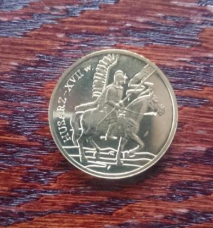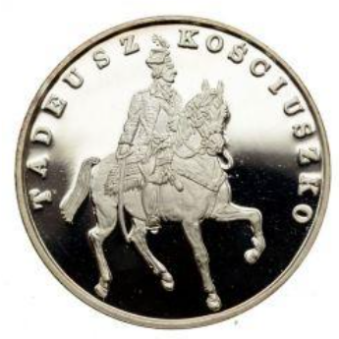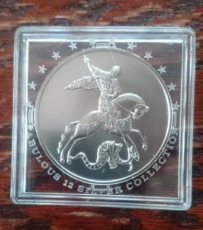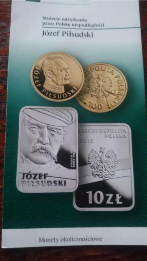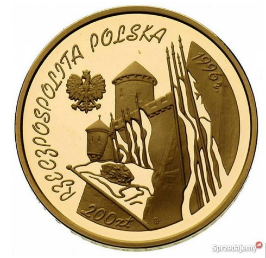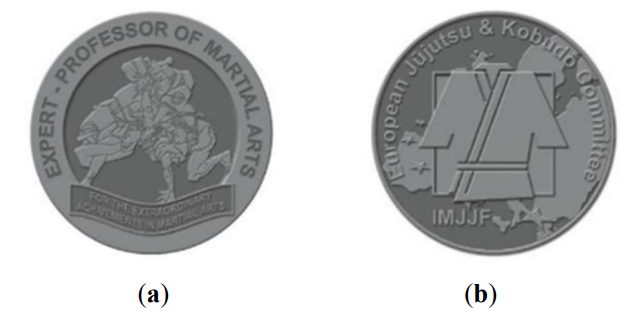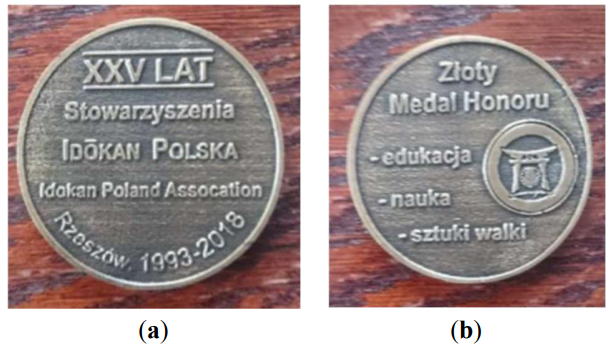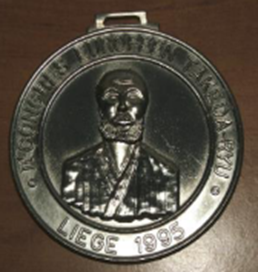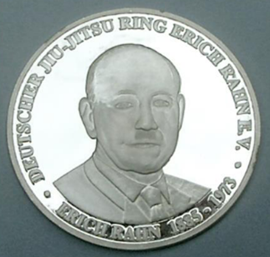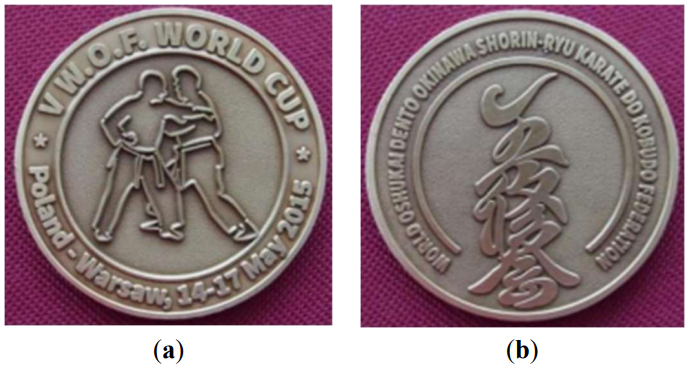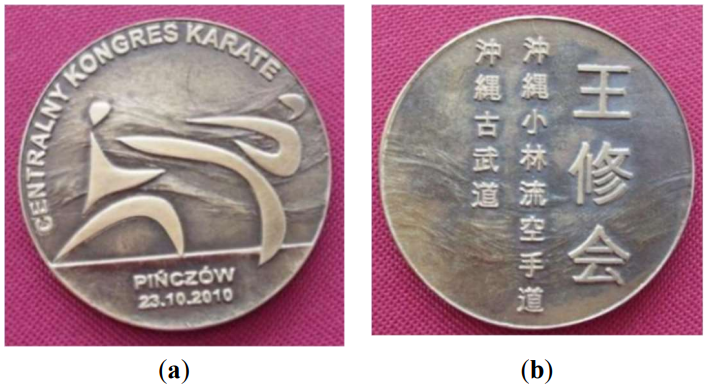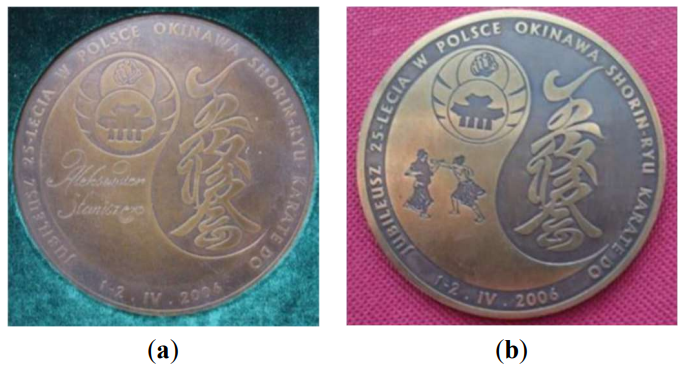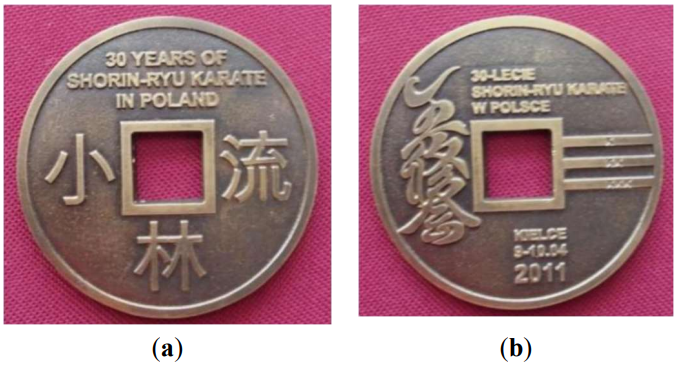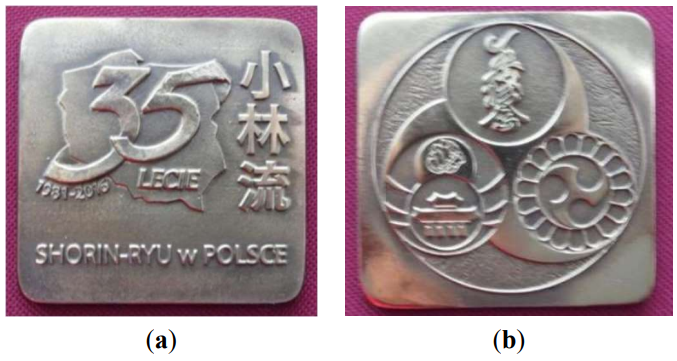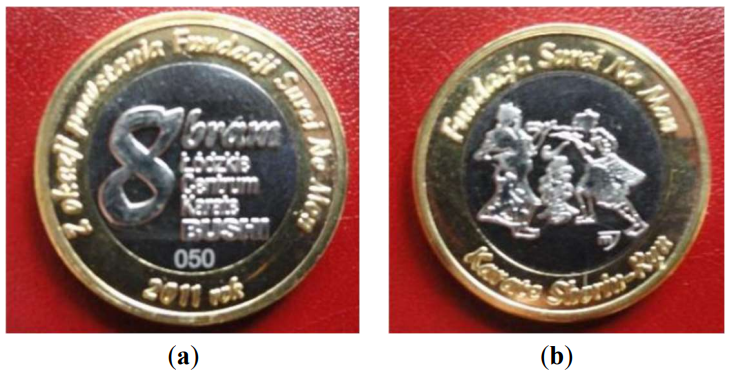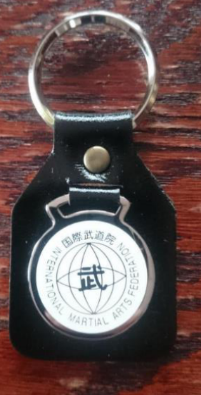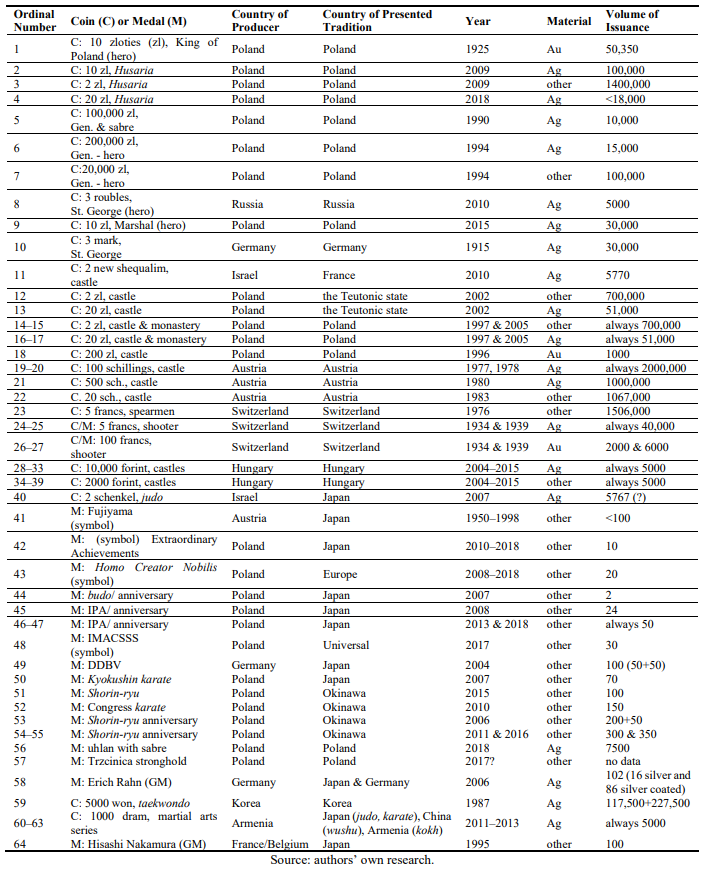Download PDF
Cite This Article
Contents
1. Introduction
2. Materials and Methods
3. Military Cultures and Warrior Traditions on Coins and Medals
4. On Medals and Badges
5. Small Statistics
6. Discussion
7. Conclusions
Acknowledgments
Ethics Statement
Informed Consent Statement
Funding
Declaration of Competing Interest
Footnotes
References
Fighting Arts on Today’s Coins, Medals and Badges: Popularity or Uniqueness
Author Information
Other Information
Institute of Physical Culture Studies, University of Rzeszow, 35-959 Rzeszów, Poland
*
Authors to whom correspondence should be addressed.
Received: 19 January 2024 Accepted: 15 March 2024 Published: 01 April 2024
© 2024 The authors. This is an open access article under the Creative Commons Attribution 4.0 International License (https://creativecommons.org/licenses/by/4.0/).
Nat. Anthropol.
2024,
2(1), 10004;
DOI: 10.35534/natanthropol.2024.10004
ABSTRACT:
Background. Medallic art is used to promote the subject matter which is important for the issuer. Also fighting arts and martial traditions are used here as icons in the coins and medals. Problem. What is the purpose of occasional coins, medals or badges relative to their contents or symbolism, the metal used or the volume of the release? Does an issuer aim at promotion or rather at recognition and at maintaining the uniqueness? Material and Method. The study uses a regression method, comparative analysis and literature review. Approximately one hundred examples are discussed. Statistical analyses took into account N = 64 of contemporary coins (47) and medals (17), representing the relevant thematic groups. Pearson C coefficient was calculated for the factor of popularity FA and a number of variables. Results. It has been found that medals are issued in small volumes and are significantly varied in terms of the subject matter (uniqueness and originality). Some organisations seek to ensure the exceptional status of medal-type award which is granted based on strictly defined rules. Conclusions. Presentations of martial arts on coins, medals and badges make reference to the related symbolism or to the issuer’s national traditions. Large volume releases are mainly done for promotional purposes. On the other hand medals issued in small numbers are meant to be unique—they find their way to a select group of people deserving special recognition.
Keywords:
Martial arts; Numismatics; Medallic art; Phaleristics; Symbolism
1. Introduction
Coin (or medal) may be treated as a work of art and cultural artefact. On the other hand money is an element of market and economy, which is subject to laws of economics, such as Gresham-Copernicus law 1, etc. In this case we are more interested in coins and other collector’s items from the viewpoint of numismatics 2, medallic art, and phaleristics 3 [1,2,3,4,5,6,7], also in terms of the motivation for their production, their contents and symbolism of the images, factors affecting their value for collectors.
We can generally distinguish monetary units—coins and banknotes (other are disregarded here), medals and tokens, badges and orders; these categories define the place where images of martial arts or certain symbols are displayed. Since there is little room, small figurative forms must be used to convey readable and comprehensible message based on pictures and letters. Symbolism of these images requires description and qualitative analysis.
The theme of fighting arts occupies only a small niche in the group of sport-related coins [8,9,10,11]. Here we also take into account certain “historical” themes. We are interested in fortifications, weapons and heroes. So it is not only the Soviet gold and silver roubles and French francs, both devoted to judo, that represent numismatics related to martial arts, or more appropriately fighting arts. The broad term fighting arts comprises combat sports, martial arts, combat systems, self-defence and the related systems [12]. At any rate, many countries worldwide issue coins depicting various fighting arts, or military traditions (military formations, commanders, memories of battles, fortifications and weapons).
As for fighting arts, coins most commonly contain references to combat sports, particularly the globally known Olympic discipline of judo, as well as boxing and wrestling. This is also frequently linked to the country of origin, like in the case of wushu which is mainly promoted in China. Images of the specific combat sports are rather frequently related to some sporting tournaments (Olympic Games, World Championships) or sporting achievements of a given country. Medals and occasional badges may also commemorate a specific master, a jubilee of an association or another event [13].
The type of material used seems important, namely whether or not it is a noble metal, and which one it is. It is undoubtedly consequential how many copies of the coin or medal are issued, whether the number correlates with the factor of popularity. Does an issuer aim at promotion or rather at recognition and at maintaining the uniqueness or a certain elitist character?
2. Materials and Methods
The study takes into account approximately one hundred events/examples of items representing numismatics, medallic art, and phaleristics. Arbitrary, non-random sampling was applied to select a set of items representative for the relevant theme; basic data (description of the image, material and number of copies) were collected for the sample. This arbitrary, theme-related selection may meet the requirements of random stratified sampling since the groups were selected based on iconography and symbolism. Therefore, it may be assumed that this is a representative and sufficient sample.
The study uses a regression method, based on the known effects, as well as inference related to causes/motivations of the entities issuing the relevant coins and medals. Additionally, methods of comparative analysis and literature review were used. Interpretation of the contents of coins and medals also required hermeneutic and semiological analyses (historical and symbolic meanings).
Statistical analyses took into account a total of N = 64. These are metal items from various countries, and from contemporary times (the 20th and 21st century), including 17 medals and 47 coins. Excel software was used to compute Pearson C correlations for factor FA and a number of variables.
3. Military Cultures and Warrior Traditions on Coins and Medals
3.1. Polish Traditions
In Poland during 1945–1989 (the time of Polish People’s Republic, PRL) the heroes promoted on coins mainly included those fitting the ideology of class warfare, such as Tadeusz Kościuszko, or fighting (particularly) with Germans and Turks, e.g., King Jan III Sobieski [11]. Those promoted also included anti-heroes, such as K. Świerczewski [14]. Later Poland issued a few series of coins depicting Polish military traditions [15]—from the guards of King Bolesław Chrobry, and hussars to contemporary soldiers.
Based on the example of Polish coins, “we can distinguish here a few categories, namely: (1) valiant monarchs and commanders, heroes, e.g., ieszko I, Bolesław Chrobry, Stefan Batory, Jan III Sobieski, Józef Piłsudski, including heroes of Poland and the USA—T. Kościuszko and K. Pułaski; (2) writers and characters linked to literary tradition, e.g. H. Sienkiewicz and Jerzy Michał Wołodyjowski, undefeated master of the sabre and a flawless knight; (3) wartime heroism and heroes, such as Polish soldiers of September 1939, Major Henryk Dobrzański “Hubal”, and Order Virtuti Militari dedicated to them; (4) fortifications, from Malbork to Zbaraż or Kamieniec Podolski (…). Noble metals emphasise the importance of a given person, anniversary, event, etc.” [11].
On special occasions, commemorative medals are also issued in addition to coins and banknotes. The medal “Independence regained” [Figure 1] depicts the commander, Marshal Piłsudski and an uhlan/cavalryman (traditional Polish mounted fencing). There is also “1920”, the year of the great victory of the Polish Army over the Red Army of the Soviet Russia. This is an example of a commemorative medal which is a type of capital investment (pure silver).
For chronological order let us start from prehistoric times. More and more often in various towns and museums we can purchase souvenir medals, tokens, local commemorative coins, and similar collector’s items. One of such places is the open-air archaeology museum in Trzcinica, known as Carpathian Troy. This is a site of an old fortified settlement from the 1500s B.C.—ancient tradition of ancient Slavic peoples (Weneti peoples, Lechites) [16,17,18]. Brass medal which can be bought here presents a part of the gate of the fortified gord (obverse) and busts of two warriors (reverse). The volume and the year of the issuance are unknown (2017?, proof finish, 32 mm)—series: Golden Poland, subseries: Golden Podkarpackie.
Historical figures still popular in Polish coins and medals include King Bolesław I Chrobry, who united a large part of Lechitic lands [17]. He is depicted on a golden 10 zloties coin (Au 900, 3.225 g, n = 50,350) in 1925. Formally, this was a coin in regular circulation but Kamiński [3] placed it in his catalogue among pattern coins. The same king appears in a series of coins issued by the Mint of Poland (of the National Bank of Poland, NBP), presenting images of Polish kings and dukes, including collector and bullion coins [19], and in gold billets in the series “Gallery of Polish Rulers” (Au 999.9, 31.1 g and smaller) produced by a commercial company and his image graces the current NBP 20 zloties banknote.
The Hussars of the 16th and 17th century secured the power of the Republic of Poland. This was an elite division consisting of well-trained sons of rich nobility (mounted fencing—Hussar sabre, shooting). The formation significantly contributed to the victory in a series of great battles [20,21]. Therefore it appears on coins, but mainly those issued after 1989. These include e.g. the 10 zloties klippe from 2009, 32 mm and 22.4 mm, Ag 925, n = 100,000 presenting an armed 17th century mounted Hussar on the revers, or the 2 zloties coin [Figure 2], in the series “History of Polish cavalry”.The battle of Hodów ranks among the great heroic battles fought by Poles in a way resembling Spartan defence of Thermopylae (series The Polish Thermopylae). 100 Polish Hussars and 300 armoured companions fought on horseback and on foot against an army of 40,000 Tatars and managed to stop them. This achievement was commemorated with silver 20 zloties coin, Ag 925/1000, 38.61 mm, 28.28 g, Mint of Poland, 2018. The revers presents a mounted Hussar, and an inscription: Hodów, 11 of June 1694; the obverse shows Athene, the Polish emblem, the face value, and inscriptions: Republic of Poland 2018, and Polish Thermopylae. Volume of the coin issuance n = 18,000.
Tadeusz Kościuszko invariably enjoys popularity both in Poland and in the USA, as a hero of both countries and nations. He was depicted in coins issued in times of PRL, and continues to be promoted, e.g. on the silver 100,000 zloties coin (39 mm, Ag 999, 31.1 g, n = 10,000, Figure 3). He is riding on horseback with his sabre, unsheathed. In 1994, on the 200th anniversary of Kościuszko Uprising, two coins featuring this hero were issued: cupronickel 20,000 zloties and silver 200,000 zloties [Table 1, positions 6–7]. Mounted Hussar and Commander Kościuszko on horseback [Figure 3] are like St. George on the coin 3 roubles, 2010 (Ag 999, 39 mm, 31.5 g, volume of issuance n = 5000) [Figure 4]. St. George, archetypal noble warrior, kills the dragon, a symbol of evil. By analogy, Polish nobility is ready to fight for higher values.Commander Józef Piłsudski was depicted on silver 2, 5 and 10 zloties coins in circulation in the Second Republic of Poland. At that time silver klippes were also issued as pattern coins, the volume of issuance ranging from 100 to 300 [3]. Perhaps because of this the centenary of Polish independence was preceded with a release of rectangular coins dedicated to him [Figure 5]. This is 10 zloties, 2015, Ag 925, 14.14 g, 32 mm and 22.4 mm, n = 30,000.Marshal Piłsudski (1867–935) was depicted on a memorial banknote of NBP and was among the four Great Poles commemorated with a collection of medals in a series “w Sieci Historii”, 2015, the others being Nicolaus Copernicus (1473–1543), Adam Mickiewicz (1798–1855) and St. John Paul II (1920–2005). The series issued by the Mint of Silesia (Mennica Śląska) comprises four medals made of brass, 30.9 mm, 12.6 g, no data regarding the volume of issuance.
3.2. Examples from Other Countries
Referred to above, St. George [Figure 4] is symbolically associated with military traditions of Imperial, Soviet and contemporary Russia. However, besides the sport-style sambo, or contemporary hand-to-hand combat systems and achievements in combat sports, it is hard to identify some special East Slavic traditions related to martial arts/fighting arts. Only Ukraine finds its heritage in a dance and combat system known as hopak. Additionally, St. George’s fighting with a dragon is found in other countries, too, e.g., in Germany, in 3 mark coin from 1915 (n = 30,000), as arms of Mansfeld [23].
Akko (Saint-Jean-d’Acre in French), is a medieval crusaders’ stronghold [24]. It was depicted on the reverse of an Israeli coin, 2 new shequalim from 2010 (Ag 925, 38.7 mm, 28 g). Similar strongholds were built on Rhodes, in Krak de Chavaliers and Carcassonne. The Teutonic Order built a fortified castle in Malbork, once a top achievement of fortification engineering, and today home to a museum. The castle [25] is shown on a 2 zloties coin from 2002, GL, 27 mm, 8.15 g, n = 700,000. In the same year silver 20 zloties coin was also issued: Ag 925, 38.61 mm, 28.28 g, n = 51,000. Other castles and fortified monasteries which can be seen on coins include e.g., Pieskowa Skała castle and Jasna Góra castle—”350th anniversary of the defence” (Poland)—the respective coins: 2 and 20 zloties [Table 1, positions 14–17].
In the territory of today’s Ukraine there are numerous castles built by Poles, e.g. Kamieniec Podolski [26], which is associated with The Trilogy by H. Sienkiewicz. Hence NBP issued a coin whose obverse shows a castle in Kamyanets-Podilsky and Polish flags (200 zloties, 1996, 27 mm, 15.5 g, Au 900, mirror finish, n = 1000, Figure 6).In Austrian coins we can see e.g., the fortress of Hochensalzburg (100 schillings, 1977, n = 2000,000), castle Orth (similarly, 1978), Styraburg (500, 1980, n = 1000,000), Burg Hochosterwitz (20 schillings, 1983, n = 1067,000) [25]. Swiss coins depict e.g. 500th anniversary of the battle of Murten (1476–1976)—5 franks, K-N, 1976, n = 1506,000), there are silver 5 frank and golden 100 frank coins representing shooting tournaments [25]. Hungarians issued a special series—”Hungarian Castles”. The series includes Visegrád (2004), Diósgyőr (2005), Munkács (2006), Gyula (2007), Siklós (2008), and Köszegi Vár (2015). The obverse design includes a portrait of Miklós Jurisics along with the text “MAGYARORSZAG” (Hungary) and the coin’s denomination of 10,000 or 2000 forint & the year of issue. The reverse depicts a perspective view of the famed castle as it is seen today, completely restored. There is always 38.6 mm, n =5000; 2000 forint—Cu75Ni25, 30.8 g; 10,000 forint—Ag 925, 31.4 g [Table 1, positions 28–39].
Martial arts and combat sports, including: scenes of combat and fighting techniques (sport fencing), as well as special places (like Shaolin) are presented:
A. Directly—martial arts in medallic items (coins, medals) if these depict combat scenes representing a specific style;
B. Indirectly—in other cases.
Situation A is illustrated by an example of 5000 won coin issued on the occasion of the Olympic Games in Soeul ‘1988; and situation B by a gilded medal issued to celebrate 1500th anniversary of Shaolin monastery (1995). The graphic contents may refer either to contemporary situations, such as sporting accomplishments, or to national traditions. A national tradition of the Kingdom of Thailand is shown on 50 bohts banknote depicting a war elephant. On the other hand Israel issued 2 schenkel coin, 2007, Ag 925, 38.7 mm, 28.8 g, mirror finish, related to judo. It was issued on the occasion of Olympic qualification of an Israel representative.
Figure 1. Ten decades of freedom. “Independence regained”—the first in a series of ten medals released by the National Treasury. Ag 999, mirror finish, 34 mm, 15.5 g, Poland 2018, n = 7500 [photo - Skarbnica Narodowa].
Figure 2. Polish Hussar, 2 zloties, 2009 (27 mm, 8.15 g, CuAl5Zn5Sn1).
Figure 4. 3 roubles, 2010, St. George [authors own collection].
Figure 5. Polish coins dedicated to the memory of Marshal J. Piłsudski from 2015 [NBP].
4. On Medals and Badges
The situation is different when it comes to medals as an award for special merits. Austrian Fujiyama Order, later known as Order of Fujiyama Knight, during 1950–1998 was the most important distinction of the international martial arts movement today referred to as Idokan organisation. It was first issued in 1950; most probably less than n = 100 copies of that medal were made, one-sided pattern, in bronze [27]. It was awarded 33 times. It was a more important distinction than Golden Medal of Honour Idokan International. In accordance with the Rules of Fujiyama Order, there could be only seven living owners of the Order. This approach was most possibly adopted to prevent its devaluation (or to preserve its elite nature). “Order of Fujiyama Knight presents only certain symbols—a meditating warrior, focusing on his inner growth, and sitting at the foot of Mount Fuji. The mountain and the Rising Sun symbolise Japanese culture and tradition of budō.” [11].In 2010 the community of martial arts received the Medal “For Extraordinary Achievements in Martial Arts” awarded along with the title “Expert - Professor of Martial Arts” [Figure 7]. Title of the “Expert—Professor of Martial Arts” [Figure 7a] on the Medal of the “Europen Jūjutsu & Kobudō Committee” and IMJJF—the International Modern Ju-Jitsu Federation [Figure 7a,b]. Later the Medal and Title is awarded by the European Martial Arts Committee (EMAC). This distinction is recognised by Idokan Poland Association (IPA), International Martial Arts and Combat Sports Scientific Society (IMACSSS) and a large part of martial arts community. Originally it was issued by the European Jujutsu & Kobudo Committee in Warsaw and the International Federation Modern Ju-Jitsu in Głogów, and later by the International Martial Arts Committee (Głogów) and European Martial Arts Committee (Warszawa and Rzeszów). A total of n = 10 pieces were released, and 9 have been awarded [Roland Habersetzer, Wojciech J. Cynarski, Lothar Sieber (in 2010), Franz Strauss (2011), Jan Słopecki (2013), Ricardo Cavalcanti, K. Kernspecht (2016), Hannelore Sieber (2017), Roland J. Maroteaux (2018)]. One medal still has not been collected (for Sergio Mor-Stabilini). Since in the case of Mr. R. Cavalcanti the requirement (European Jujutsu & Kobudo Committee/European Martial Arts Committee, EMAC) related to the rank of 8 dan was not satisfied, he is not included in the formal list of EMAC by IPA. In fact the series was ended.
Order of Knighthood Homo Creator Nobilis is also (since 2008) one of the most important distinctions in the community of modern day Warriors of Truth and Noble Path (European Nobility Club and IPA). With the number of copies n =20, only 7 persons have been honoured this way so far (end of 2018): (Wojciech Zabłocki, Andrzej Szyszko-Bohusz, Lothar Sieber, Roland J. Maroteaux, Keith Kernspecht, Jan Słopecki, Andrzej Pawłucki).
Some organisations issue more medals, others do not do it at all. This fact may be linked to preferences of the organisation leader. It also happens medals are issued by private persons, e.g., as in the case of “30 years Budo of W.J. Cynarski”—copies n = 2, one-sided, brass (in Rzeszów 2007, [11]).
To celebrate the 15th anniversary of Idokan Poland Association (IPA) a brass badge was issued, n = 24 pieces. The Medal “20 years of IPA”, or the “Silver Badge of IPA”, was released in a greater number of copies, n = 50, and 36 have been awarded (as of 22 of December 2018). 25th anniversary of IPA was celebrated with “Golden Medal of Honour”—issue of n = 50 pieces. Designed by W.J. Cynarski, it was made by Robert Baran, “Artgraw” company (who also produced medal for 20 years of IPA). However only 6 of these badges have been awarded [Figure 8; [28]. Following Cynarski’s initiative Medal of Honour IMACSSS, was also issued, with number of copied n =30, and so far only one has been awarded (in October 2018).“The DDBV Badge”, of the German Association of Budo Teachers, was issued in a few versions. The great honorary DDBV badge was issued, with the volume of release 50 + 50 (two versions: with a pin and a safety-pin). It presents logo of DDBV. The phenomenon is more comprehensively discussed by Bodo Blumentritt [29]. Medal of the World Takeda-ryu Morotokan Federation (WTMF), founded in 2008, was made in four versions (bronze, silver, gold and grand gold), and is awarded for meritorious achievements for WTMF. The Grand Gold Medal was awarded only 8 times. Leader of WTMF, Roland Maroteaux, was earlier president of the European Sobukai Takeda-ryu, EST. On the occasion of 1995 Congress of EST in Liege a medal with the image of soke Hisashi Nakamura was released (n = 100, Figure 9).In 2006 the DJJR “Erich Rahn” e.V. founded the Erich Rahn Commemorative Medal (die Erich Rahn Gadenkmedaille). The first 6 medals were awarded for the 100th anniversary of the E. Rahn’s school in Berlin. It was made in silver, with mirror finish (Figure 10). So far only 27 medals have been awarded.
This Medal, featuring the bust of the outstanding German master in jujutsu and judo, can be received for achievements in martial arts from Deutscher Jiu-Jitsu Ring “E. Rahn” e.V. (DJJR). Sensei Cynarski was awarded the medal for the 25 years of studies in the “Jiu-Jitsu und Karate-Schule Sieber” on the 40th anniversary of the school. On the other hand, a jubilee of Kyokushin karate in Tarnów and 30th anniversary of the club was celebrated with a large medal (bronze, diameter of 50 mm, n = 70) which was issued complete with a casing with the name of the recipient. On the obverse, around the edge there is an inscription: “Tarnowski Klub Sportowy Kyokushin Karate”, years 1977–2007 and ideograms for the name of the style, arranged in the shape of a stylised lily. On the reverse: logo “kanku”, two phoenixes and subtitles” 30 lat KARATE KYOKOSHIN”, “ZA ZASŁUGI”. This was organised by sensei Wiesław Gwizd.
Special medals issued by the Polish Union Shorin-Ryu Karate Kobudo, were designed by sensei Aleksander Staniszew. These are Figures 11–15 (courtesy of A. Staniszew). His organisation emphasises the cultural distinctiveness of karate and Okinawa from Japan [30,31].
Martial arts are supported by various foundations (Figures 16a,b—token “8 bram” of the “Fundacja Surei no Mon”) and other organisations, such as International Martial Arts Federation (IMAF) seated in Tokyo (Figure 17). These organisations at the same time promote themselves. In this case it is not about the elite group of those entitled to the items produced by them.Other organisational badges present similar contents as stickers and patches with symbols of organisations representing various fighting arts [32]. These include, e.g.,: (1) German badge sakura (Japanese cherry blossom) with Red Sun in the middle and golden ideograms “ju-jutsu” (diameter 18 mm); (2) badge of IKO (International Kyokushinkai Organization) with inscriptions: “Oyama’s Karate ∗ Kyokushinkai Karate-Do”, image of karate fighters and a signs for kanku (a look to the sun) (round, 18 mm); (3) badge of the Łódź Club of Far Eastern Culture Enthusiasts, with the club name and dragon, as well as riveted kiku—chrysanthemum (symbols of China and Japan), diameter 25 mm; 4) badge, the only one made of plastic, with inscription “Ośrodek Walk Wschodnich ∗Promień Kraków∗” and a drawing of fighting judoka or jujutsuka, 27 mm. All of these were issued approximately 30–35 years ago. The badges for jujutsu and Kyokushin karate may have been issued in 1000 copies, and the numbers of the badges from Kraków and Łódź clubs possibly were in the range of n = 200–300.
Figure 7. Medal of EJKC, sponsored by IMJJF [courtesy of IMJJF]. (a) fighting jujutsuka and: “Expert - Professor of Martial Arts”, “For Extraordinary Achievements in Martial Arts”; (b) keikogi and “European Jūjutsu & Kobudō Committee”, “IMJJF” (International Modern Ju-Jitsu Federation).
Figure 8. Medal of EJKC, sponsored by IMJJF [courtesy of IMJJF]. (a) fighting jujutsuka and: “Expert - Professor of Martial Arts”, “For Extraordinary Achievements in Martial Arts”; (b) keikogi and “European Jūjutsu & Kobudō Committee”, “IMJJF” (International Modern Ju-Jitsu Federation).
Figure 11. W.O.F. World Cup; two-sided medal released for the special occasion (it was not awarded to competition winners)—brass, diameter 60 mm, n = 100. (a) Karate fighters and: V W.O.F. WORLD CUP ∗ Poland-Warsaw, 14–17 May 2015, (b) World oshukai dento okinawa shorin-ryu karatedo kobudo federation.
Figure 12. Central Karate Congress (written in Polish, and ideograms); two-sided medal, brass, diameter 70 mm, n = 150. (a) centralny kongres karate/pińczów 23.10.2010; (b) words about karate and kobudo in Chinese/Japanese.
Figure 13. 25 years of Shorin-ryu in Poland; the first one-sided medal, brass, diameter 70 mm, n = 200; the second one-sided medal, name engraved; bronze, diameter 120 mm, n = 50. (a) Jubileusz 25-lecia W polsce okinawa shorin-ryu karatedo/1–2. IV. 2006/Aleksander Staniszew; (b) the same words and picture: fighting of Okinawa karate athletes.
Figure 14. 30 years of Shorin-ryu in Poland; brass, 80 mm, in the middle a square opening with sides of 20 mm, n = 300. (a) 30 years of shorin-ryu karate in poland; (b) 30-lecie shorin-ryu karate W polsce/kielce 9-10.04.2011.
Figure 15. 35 years of Shorin-Ryu in Poland; square, with sides of 75 mm, brass, n = 350. (a) 35 lecie 1981–2016 shorin-ryu w polsce; (b) name, school logo and emblem of the Ryukyu Kingdom.
Figure 16. Token (jetton?) of Surei no Mon Foundation—”8 Gateways”, Lodz (Łódź) 2011 [courtesy of Surei no Mon]. (a) “Z okazji powstania Fundacji Surei No Mon/8 bram Łódzkie Centrum Karate BUSHI 050/2011 rok”; (b) “Fundacja Surei No Mon/Karate Shorin-Ryu”. Fighting worriors and Shorin-ryu written in ideograms.
Figure 17. Key holder with an emblem of IMAF [own collection].
5. Small Statistics
To determine the factor of relative popularity or uniqueness we assume here (Equation 1):FB = 1/FA means that FB is the opposite of FA
Where: FA—factor of relative popularity; FB—factor of relative uniqueness. N—number of all the items taken into account in the study (Table 1). N1 is the total of all the items (medals or coins) related to a given military tradition, type of combat sport or martial art, line of communication/master, etc.
Is uniqueness not connected with elite nature? We assume that the number of products is directly proportional to the factor of popularity of a given type of fighting art. Is there a correlation between the number of copies and the factor of popularity (FA)?
Here we can find the following categories: Hero or GM—Grand Master, name of military formation (husarz/husaria, uhlan, spearmen), fortification (castle, stronghold), name of martial art or a style/school, weapon, or symbol. In this way e.g. for category of “Hero” would be N1 = 8 - including: Bolesław Chrobry, Kościuszko, St. George, Piłsudski or Rahn. Certainly the calculations can as successfully take into account the category of Hero, as specific figures, e.g., T. Kościuszko. Equation 2:However, for Armenian kokh it would be: FA = 1.56%; FB = 64 = N; n = 5000 (pos. 63, silver). Husaria is found in three items, FA = 4.68%. For position 2 in Table 1 (silver 10 zl) the number of copies is 100,000. Here we can clearly see a correlation between the volume of issuance and the factor of relative popularity FA.
Gold coins are issued rarely and in small numbers of copies (higher costs), and silver coins are less frequent that those from non-noble alloys. Developing organisations, such as Idokan (IPA) and Shorin-ryu, issue medals in growing numbers of copies, but these are made of bronze or brass. Only large organisations (e.g., the German DJJR “E. Rahn” e.V.) can afford to release mirror finish silver medals (Table 1, positon 58).
Does the number of copies issued correlate with the factor of popularity FA? No such correlation was found in the case of coins. For medals the correlation was only moderate (r = 0.6). There is low correlation in the case of medals made from non-noble metals (0.22) and very low for silver medals (0.12) and gold coins (0.18).
Does an issuer aim at promotion and increased popularity or rather at recognition and at maintaining the uniqueness or a certain elitist character? It can be assumed (by deduction and using regression analysis) that some organisations aim at maintaining uniqueness of the distinction, awarded according to strict rules. They seem to try to avoid devaluation of a given medal or order.
The study analysed only N = 64 events/examples of items representing numismatics and medallic art. This was a preliminary study preceding a systematic quantitative research.
FA = N1/N × 100%
FA = 8/64 × 100% = 12.5%; FB = 1/FA = 8.0
Table 1. Examples coin and medals with martial topics: basic data.
6. Discussion
Small graphic forms, such as postal stamps and coins should present easily readable communications. These usually include texts and images—figures and symbols. Notably, the same icons, e.g., a dragon, refer to completely different imagery in European culture compared to China. Themes presented here are linked to warfare or sport type combat. This may be determined by the specific experiences of the given country or nation.
The examples referred to earlier and the aforementioned roubles do not cover the entire subject. We could discuss here other collector items, such as the Vietnamese silver 100 dong coin from 2000 presenting Eagle Claw kung-fu (Ag 925, 38.61 mm, 25 g, volume of issuance 10.000) or the Chinese gold 2000 yuan coin from 2008 (Au 999.9, 60 mm, 155.52 g, 2008 copies)—four styles of wushu kung-fu [33].
The presence of castles and fortified monasteries in Polish and Hungarian coins may be linked with the similar, over 1000 year old history of these Christian states when the nations were in serious danger and had to defend themselves. Therefore the places of combat and the heroes remain in the memory of the societies. The study deliberately ignored the well-known numismatic exhibits, i.e., siege coins minted in strongholds under siege. Here we took into account only items issued in the 20th and the 21st century.
Symbolism of images seen in medals and coins generally is similar to that which occurs in emblems of martial arts and combat sport organisations [32]. Hence, it is determined by the cultural tradition to which it refers, e.g., Chinese (wushu), Japanese (budo, judo) or Korean (taekwondo). Staniszew medals make reference to the traditions of Chinese, Okinawa and Japanese coins [6], to the iconography and names of these places. The symbols of Japan include cherry blossoms (sakura), chrysanthemum (kiku), and a look into the sun (kanku). On the other hand symbols specific to China include dragon, phoenix, yin-yang. Medals and badges related to traditions of fighting arts from a given country intentionally make reference in the imagery linked to the symbolism of that specific country and its culture. In the case of coins, the important elements include texts in the relevant national language, emblems of the countries, and logo of the institution—the issuer. This basically has not changes since Antiquity [7].
The iconography adopted is either universal for the entire cultural area or specific for a given national culture. Saint George as a motif occurring in knighthood crosses, medals or orders is not specific only to Russia. He can be seen, e.g., in Italian or Papal orders and in the Polish order of Homo Creator Nobilis [2,5,34]. This is because he is part of the pan-European chivalric heritage and a symbol of struggle of good against evil. The medal “Ten decades of Polish independence” with an Uhlan and Marshal Józef Piłsudski as well as coins with Hussars make direct reference to the Polish traditions of struggle for independence and Polish military history. Still fairly unknown, Hussar sabre and sabre fencing, in particular mounted fencing, are a Polish specialty and are cultivated even today [35,36].
It is a known fact that today even the commemorative coins issued by state entities contain less and less pure silver [37]. Hence the fact that a coin or medal is made of finer silver (or gold) is a manifestation of its uniqueness, or is linked with a desire to sell it with better profit. Therefore, the uniqueness is mainly determined by the volume of issuance. We can guess that a purchaser acquires items of this type to make an investment (in the case of noble metals), or for their collection (passion more important than profit); such an item may also be kept as a souvenir by those awarded. In fact some medals cannot be simply bought. They are only awarded in a numbered series. Alternatively, someone who has been honored with such a medal may sell their medal later.
On the other hand it is possible to purchase collector coins, such as the series of two coins, issued by NBP on 27 February 2019, presenting Polish King Stephen Báthory: 500 zloties, Au 999.9, 45 mm, 62.2 g, number of copies up to 600, and 50 zloties, Ag 000, 45 mm, 62.2 g, up to 5500, year 2019. This great and victorious commander definitely deserves this kind of tribute. Obviously, gold coin is issued in a small number of copies, since it is expensive and is purchased by few expert hobbyists or as an investment.
Medals of Idokan International and European Martial Arts Committee (formerly the European Jujutsu & Kobudo Committee), Cross (Knight's Order) Homo Creator Nobilis, and “Golden Medal of Honour” IPA were released as a mark of extraordinary distinction [34,38]. At a given time it is legally owned by only 6–8 people. On the other hand many other medals and commemorative coins are to a greater extent used as a promotion of specific ideas.
7. Conclusions
The small sample and the low correlations do not permit far-reaching claims. For the time being one can only conclude that presentations of martial arts on coins, medals and badges, A.D. 2018, make reference to the related symbolism or to the issuer’s national traditions. Large volume releases are mainly minted for promotional purposes, as commemorative coins or medals. On the other hand medals issued in small numbers are meant to be unique—they find their way to a select group of people deserving special recognition.
Acknowledgments
I would like to acknowledge Mr. Aleksander Staniszew, the Polish karate teacher of high rank, for the photos of his medals.
Ethics Statement
Not applicable.
Informed Consent Statement
Not applicable.
Funding
This research received no external funding.
Declaration of Competing Interest
The author declares that he has no known competing financial interests or personal relationships that could have appeared to influence the work reported in this paper.
Footnotes
1 The principle that if there are two types of money at the same time, legally equivalent, but one of them is perceived as better (e.g., with a higher metal content), this “better” money will be accumulated (hoarded), and mainly the “one” will remain in circulation worse”. In short, worse money drives out better money
2 This is an auxiliary science of history, dealing with the study of coins, banknotes and other monetary symbols from a historical, aesthetic and technical point of view.
3 It is an auxiliary science of history dealing with orders, decorations and other badges and honorary signs awarded to people who have made outstanding contributions to the monarch, state or other organization with the right to award decorations.
References
1.
Bernhardt M, Kroha T. Medaillen und Plaketten, 3rd ed.; Klinkhardt & Biermann Verlagsbuchhandlung GmbH: Munich, German, 1984.
2.
Gritzner M. Handbuch der Ritter-Und Verdienstorden aller Kulturstaaten der Welt; Reprint-Verlag: Leipzig, Germany, 1893 [In German].
3.
Kamiński C. Ilustrowany Katalog Monet Polskich 1916–1982 [Illustrated catalogue of Polish coins 1916–1982], KAW: Warszawa, Poland, 1983 [In Polish].
4.
Rościszewski JE. Tradycja historyczna w symbolu. Jeszcze o falerystyce [Historical traditions in symbols. More about phaleristics]. Biul Numizmat 1986, 5–8, 112–116 [In Polish].
5.
Scharfenberg G, Thiede G. Lexicon der Oederskunde. Von Adlerschild bis Zitronenorden; Battenberg: Regenstauf, Germany, 2010 [In German].
6.
Villaret de E. Numismatique Japanaise; Bunkasha International: Tokyo, Japan, 2014.
7.
Wicks RS. The Ancient Coinage of Mainland Southeast Asia. J. Southeast Asian Stud. 1985, 16, 195–225. [Google Scholar]
8.
Czaplicki Z. Sport coins. Biul Numizmat 2006, 3, 213–218. [Google Scholar]
9.
Czaplicki Z. Sport and Olympic Games on collector coins. In Sport w Kulturze Zdrowia, Czasu Wolnego i Edukacji Olimpijskiej w 150-Lecie Urodzin Pierre’a de Coubertin; AWF: Warszawa, Poland, 2013, pp. 440–458 [In Polish].
10.
Czaplicki Z, Czaplicki K. Ateny 2004—XXVIII Igrzyska Olimpijskie na monetach polskich [Athens 2004—28th Olympics on Polish coins]. Sport Wyczyn 2004, 7–8, 126–128 [In Polish].
11.
Sieber L, Cynarski WJ. Sztuki walki na monetach i medalach [Martial arts on coins and medals]. Ido Mov. Cult. 2008, 8, 139–150. [Google Scholar]
12.
Cynarski WJ. Martial Arts & Combat Sports: Towards the General Theory of Fighting Arts; WN Katedra: Gdańsk, Poland, 2019
13.
Other martial arts coins and tokens. Available online: http://www.judostamps.org/judostamps/Other_Martial_Arts_Coins_and_Tokens/Pages/Jujitsu_coins.html (accessed on 21 December 2018).
14.
Cynarski WJ. The anti-hero in symbolic space. Ido Mov. Cult. J. Martial Arts Anthropol. 2017, 17, 1–8. [Google Scholar]
15.
Cynarski WJ, Cynarski ŁR. Polish coins depicting martial arts and the art of war. Ido Mov. Cult. J. Martial Arts Anthropol. 2015, 15, 1–10. [Google Scholar]
16.
Cynarski WJ. Heritage of Proto-Aryan ancestors and noble warriors in Central Europe. Ido Mov. Cult. J. Martial Arts Anthropol. 2018, 18, 11–24. [Google Scholar]
17.
Cynarski WJ, Maciejewska A. The proto-Slavic warrior in Europe: The Scythians, Sarmatians and Lekhs. Ido Mov. Cult. J. Martial Arts Anthropol. 2016, 16, 1–14. [Google Scholar]
18.
Haarmann H. Auf Den SPUREN Der Indoeuropaeer. Von Den Neolitischen Steppennomaden Bis Zu Den Fruehen Hochkulturen; Beck C.H.: Munich, Germany, 2016 [In German].
19.
Kurpiewski J. Katalog–Cennik Monet Polskich 1916–1989 [Catalogue and Pricelist of Polish Coins 1916–1989]; PTAiN: Warszawa, Poland, 1990 [In Polish].
20.
Żygulski Z Jr. Husaria Polska [Polish Hussars]; Pagina: Warszawa, Poland, 2000 [In Polish].
21.
Sikora R. Niezwykłe Bitwy i Szarże Husarii [Astounding Battles and Charges of Winged Hussars]; PTAiN: Warszawa, Poland, 2011 [In Polish].
22.
Monety. Available online: www.monety.gdynia.pl (accessed on 15 December 2021).
23.
Schön G. Kleiner Deutscher Münzkatalog. Mit Österreich, Schweiz und Liechtenstein ab 1871. 1996/97; Battenberg: Augsburg, Germany, 1996 [In German].
24.
Holt PM, Czarska B. Bliski Wschód od Wypraw Krzyżowych do 1517 Roku [The Near East from the Crusades until 1517]; Państwowy Instytut Wydawniczy: Warszawa, Poland, 1993 [In Polish].
25.
Cynarski WJ. Castles as the heritage of Polish fortification art and as a tourist attraction. Ido Mov. Cult. J. Martial Arts Anthrop. 2012, 12, 44–55. [Google Scholar]
26.
Maciuk O. Zamki i Twierdze Ukrainy Zachodniej. Wędrówki Historyczne; Centrum Europy: Lwów, Ukraine, 2008 [In Polish].
27.
Sieber L, Cynarski WJ. A new stage in the history of the Idokan organization. Ido Mov. Cult. J. Martial Arts Anthropol. 2013, 13, 59–71. [Google Scholar]
28.
Sieber L, Cynarski WJ, Korobeynikov G, Bielec G, Palys A, Niemiec E. Events, facts and comments AD 2018. Ido Mov. Cult. J. Martial Arts Anthropol. 2019, 19, 75–81. [Google Scholar]
29.
Blumentritt B. Badges and honorary pins used by Deutscher Dan-Träger und Budo-Lehrer Verband e.V. Ido Mov. Cult. J. Martial Arts Anthropol. 2019, 19, 63–65. [Google Scholar]
30.
Alexander GW. Okinawa—Island of Karate; Yamazato Publications: West Palm Beach, FL, USA, 1991.
31.
Polska Unia Shorin-Ryu Karate Kobudo. Available online: http://www.okinawakarate.pl (accessed on 26 December 2018).
32.
Sieber L, Cynarski WJ, Litwiniuk A. Symbolika na emblematach różnych organizacji sztuk walki [Symbolism in emblems of various martial arts organisation]. Ido Mov. Cult. J. Martial Arts Anthropol. 2008, 8, 133–138. [Google Scholar]
33.
Schön G, Krämer S. Welt Münzkatalog, 21. Jahrhundert 2001–2016, 3rd ed.; Battenberg: Regenstauf, Germany, 2017. [In German].
34.
Cynarski WJ, Szajna G. The nobility of spirit—Homo Creator Nobilis. Towards the anthropology of the knightly way. Ido Mov. Cult. J. Martial Arts Anthropol. 2017, 17, 1–8. [Google Scholar]
35.
Sawicki Z. Influence of the Polish martial art onto European armies in the 18th and 19th centuries—an outline. Ido Mov. Cult. J. Martial Arts Anthropol. 2014, 14, 3–13. [Google Scholar]
36.
Wagner E. Hieb- und Stichwaffen; Artia: Prague, Czech Republic, 1975 [In German].
37.
Gromiec JP. Srebro w monetach współczesnych [Silver in contemporary coins]. Biul Numizmat 1984, 1–2, 5–10 [In Polish].
38.
Sieber L, Pawelec P. Professors of martial arts. Holders of this title in martial arts science. Ido Mov. Cult. J. Martial Arts Anthropol. 2016, 16, 15–26. [Google Scholar]


